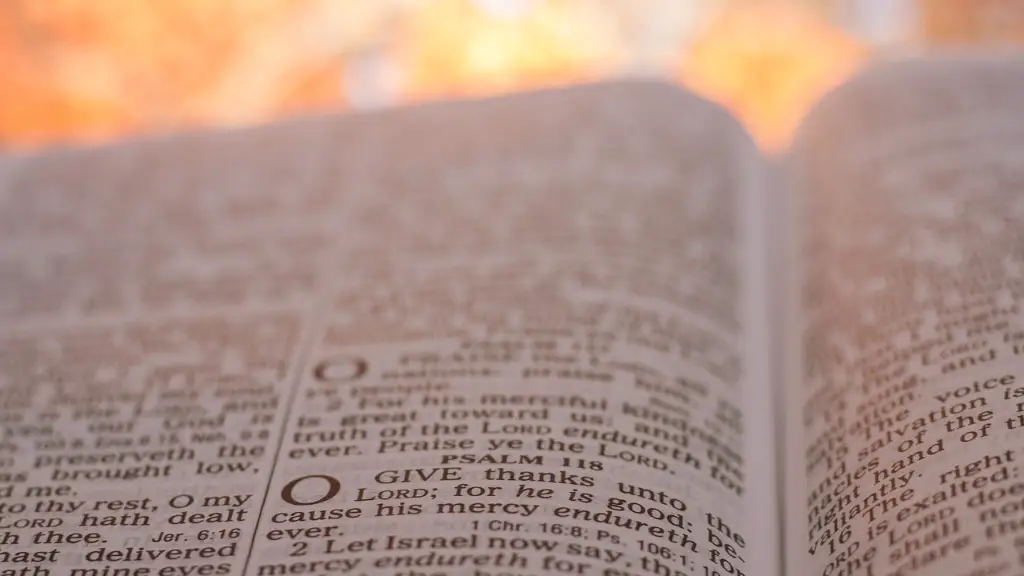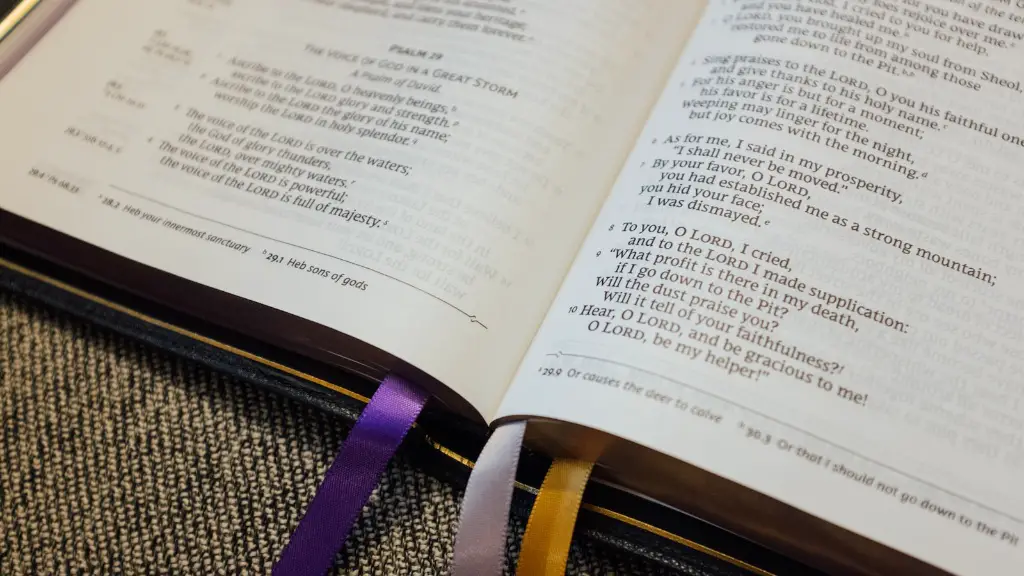In Genesis, God is presented as the creator of the world and everything in it. He is all-powerful and all-knowing. He is also a loving God who desires to have a relationship with his creation. The image of God is also seen in Jesus Christ, who is the perfect example of what it means to be human. Christ shows us that God is a God of love and forgiveness.
The image of God in the Bible is that of a loving and caring father who is always there for his children. He is a source of strength and comfort in times of trouble and a guide through life’s challenges. God is also a righteous and just judge, who punishes those who do wrong and rewards those who obey him.
What does the Bible say about the image of God?
The phrase “in the image of God” has been debated for millennia. Some people believe that it means that humans are made in the physical image of God. Others believe that it means that we are made in the spiritual image of God. Either way, it is clear that we are made in the image of God and that we are special and unique.
The image and likeness of God in Genesis 1:26-27 are interpreted from the functional, relational, and substantive perspectives or a combination of these. Each of these perspectives has its own strengths and weaknesses, and each provides a different lens through which to view the text.
The functional perspective sees the image and likeness of God as referring to the functions that humans are to perform in the world. This perspective has the strength of being able to see the text as a whole, and it is also able to see the image of God as something that is to be enacted in the world. However, this perspective has the weakness of being overly literalistic and not allowing for a more nuanced understanding of the text.
The relational perspective sees the image and likeness of God as referring to the relationships that humans are to have with God and with others. This perspective has the strength of being able to see the text as a whole, and it is also able to see the image of God as something that is to be enacted in the world. However, this perspective has the weakness of being overly literalistic and not allowing for a more nuanced understanding of the text.
The substantive perspective sees the image and likeness of God as referring to the inherent nature of humans as being
What is the importance of the image of God
First, to be created in God’s image means that we have been given a unique status, a divine dignity as human beings. It means that God has set us apart and made us a very special creation in this world. As Christians we cannot forget the significance of this special honor that God has bestowed upon all humanity.
The term “image of God” has its roots in Genesis 1:27, which states that “God created man in his own image.” This passage does not mean that God is in human form, but rather, that humans are in the image of God in their moral, spiritual, and intellectual nature.
Why did God create us in his image?
God is love, and he created the world out of that love. As the capstone of his creation, he created people in his image, so that we could share in his love, grace, and goodness. Our relationships with the Trinity—Father, Son, and Holy Spirit—are the way that we experience and receive God’s love.
The Bible describes us as being made in the image of God or as God’s image bearers. Basically, what this means is that we reflect something of God’s nature and character to the rest of creation. This is a huge responsibility and one that we should take very seriously. We should strive to be like God in every way possible and to show his love and mercy to those around us.
What is the image of God in the New Testament?
The doctrine of the Trinity is one of the most difficult doctrines of the Christian faith. It is also one of the most important. The Trinity is the doctrine that states that there is one God in three persons, the Father, the Son, and the Holy Spirit. This doctrine is a mystery because it is impossible for us to fully understand how three persons can be one God. However, the mystery of the Trinity is not an unsolvable mystery. We can know some things about the Trinity through what has been revealed to us in the Bible. The doctrine of the Trinity is important because it is who God is. This doctrine tells us that there is one God who is eternally existing in three persons. Each person of the Trinity is fully God. This means that there is one God who is infinitely powerful, omniscient, and good. This also means that there is one God who has revealed himself to us as our Father, our Savior, and our Comforter. When we try to understand the Trinity, we must remember that we will never fully understand it. However, we can praise God that he has revealed himself to us as Trinity.
In these verses, God explains His intention to create mankind in His image and likeness, and to give them dominion over the fish of the sea, the birds of the air, the cattle, and all the earth. This dominion is to be exercised with wisdom and justice, in order to reflect the character of God Himself.
Do Christians have images of God
Since the 1800s, devotional art has become very popular in Christian homes. Wall crosses, embroidered verses from the Bible, and images of Jesus are all common examples of devotional art. This type of art is a great way to promote religious conversation and to help people feel closer to God.
The reason that the Israelites were prohibited from making any physical representations of the divine is because, at the time the Ten Commandments were given, they saw no shape or form. This is stated as a reason why any physical representation of the divine is prohibited – no idols of humans, animals, or heavenly bodies were to be made.
Where in the Bible does it say Jesus is the image of God?
In Colossians 1:15-16, we see that Christ is the image of the invisible God and the firstborn of all creation. In him, all things in heaven and on earth were created, things visible and invisible, whether thrones or dominions, principalities or powers. All were created through him and for him. This shows us the greatness of Christ and his supremacy over all creation.
The Church is traditionally understood as having three different aspects or “images”: the People of God, the Body of Christ, and the Temple of the Holy Spirit.
The People of God is a term that describes the Church as the community of God’s chosen people, who are called to live in covenant with him. This image emphasizes the Church’s mission to proclaim the Good News of salvation to all people, and to be a light to the nations.
The Body of Christ is an image that describes the Church as being united with Christ, who is the Head. This image emphasizes the Church’s unity in Christ, and our call to work together for the common good.
The Temple of the Holy Spirit is an image that describes the Church as a place where the Holy Spirit dwells. This image emphasizes the Church’s role as a place of worship and prayer, and our call to be filled with the Spirit and to bear fruit for the Kingdom.
What are the 3 P’s for God
If you find yourself feeling overwhelmed or stressed, take a step back and remember the three P’s: pause, presence and prayer. Practicing these three things can help you to find peace and clarity in the midst of chaos.
God is traditionally described as a being that possesses at least three necessary properties: omniscience (all-knowing), omnipotence (all-powerful), and omnibenevolence (supremely good).
What do the three faces of God represent?
Pope Urban VIII’s 1628 censorship of “Trifacial” representations of the Holy Trinity was motivated by a belief that such images could lead to heresy. The censorship was largely successful, and trifacial images of the Holy Trinity are now quite rare.
An icon is a religious work of art, most commonly a painting, in the cultures of the Eastern Orthodox, Oriental Orthodox, and Catholic churches. They are not simply artworks; “an icon is a sacred image used in religious devotion”.
What are the list of images in Holy Spirit
The symbols of the Holy Spirit are: Dove, Fire, Oil, Wind and Water
The Dove: This can be seen in the description of the baptism of Christ (Matt. 3:16). The Spirit descended on him like a dove.
Fire: This is another symbol of the Holy Spirit. It can be seen in the story of Pentecost when the disciples were filled with the Holy Spirit and they spoke in tongues of fire (Acts 2:3-4).
Oil: This is a symbol of the anointing of the Holy Spirit. It can be seen in the story of the seven churches in Revelation (Rev. 1:20; 4:5).
Wind: This is another symbol of the Holy Spirit. It can be seen in the story of Pentecost when the disciples were filled with the Holy Spirit and they spoke in tongues of fire (Acts 2:3-4).
Water: This is a symbol of the cleansing power of the Holy Spirit. It can be seen in the story of the woman at the well (John 4:1-42).
The Divine Image presents the figures of Mercy, Pity, Peace and Love as the four virtues which are objects of prayer in moments of distress. Blake praises God for his lovely caring and blessing which comfort man. This poem is a beautiful expression of Blake’s faith and trust in God.
Conclusion
There is no definitive answer to this question as the Bible does not explicitly state what the image of God is. However, many Christians interpret the image of God as being the qualities that make us distinctly human, such as our capacity for love, reason, and creativity.
The image of God in the Bible is that of a loving and caring deity who is interested in the well-being of humans. This image is reflected in the many stories and passages in the Bible that depict God as a loving and merciful being.





